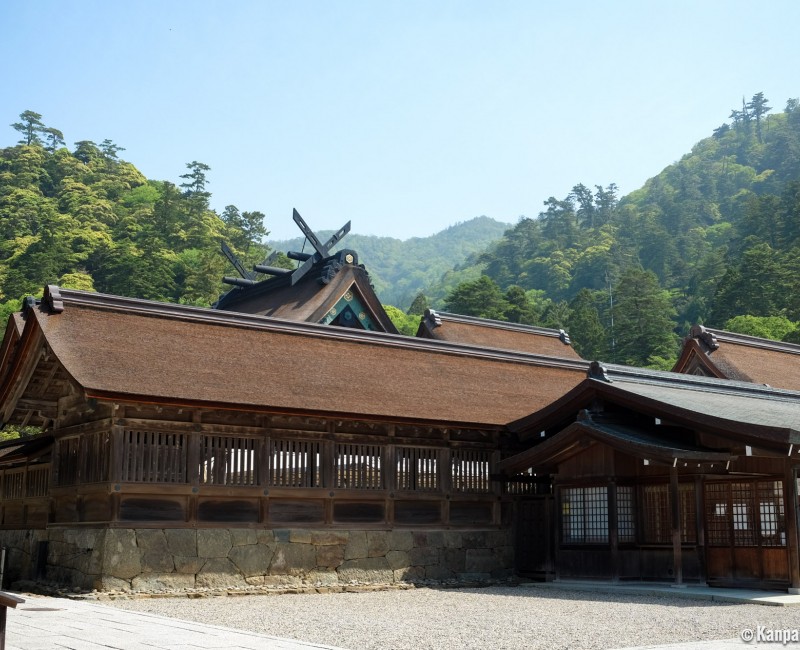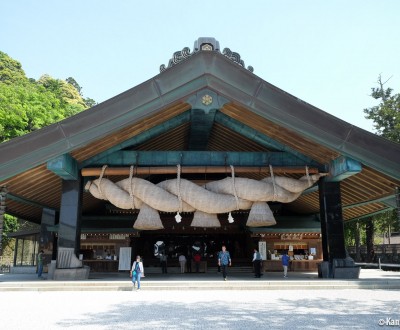Izumo Taisha
Shimane’s Grand Shrine
Izumo Taisha is a Shinto shrine complex located in Izumo city on the Sea of Japan in Shimane prefecture and considered as one of the country’s cradle. With origins dating back at least to the 8th century, it is one of the oldest shrines in the archipelago. The present great main building was built in 1744 in the Taisha-zukuri style and is listed as a National treasure of Japan since 1952.
History and myths meet in Izumo. An ancient place of spiritual and temporal powers, Izumo Taisha is the second most important Shinto shrine in Japan, after Ise Jingu.
Okuninushi is worshipped as the god creator of the nation, of spirits, business and medicine, as well as en-musubi, or the binding of destinies and good relationships, very important in the area.

A unique and spectacular shrine
Even carefree visitors immediately feel the sacred atmosphere of the place. The complex's imposing architecture gives a mixed feeling between the vulnerability of life on earth and the eternity of kami deities. Huge torii ⛩️ gates signal the entrance to the site. Impressive is a feeble word to describe the massive shimenawa cord, that weights 5,2 tons and is suspended to the Haiden, the prayer hall. The 24 meters high Hondo, the main building, is the highest Shinto construction in the country. Archeological excavations found that one of the older version of the shrine was probably 48 meters high, built on numerous and wide wood pillars.
Izumo Taisha shrine pledged allegiance to Ise shrine, ruled by the Yamato clan, but it is still displaying particular features in its cult. First, Shinmondori, the main alley connecting to the central worshipping area, goes downwards; in most Shinto shrines, it usually goes upwards. The way to pray the enshrined deity Okuninushi is also slightly different. One must:
- Bow twice; then,
- Clap four times (and not twice);
- Then bow one last time.

An all-Japan divine gathering place
In autumn 🍁, the shrine hosts a unique event: the gathering of kami deities from the whole country, to discuss fates and harvests for the next year. The gods are said to arrive by Matsu no Sando, "the pines alley", whose central path is forbidden to human who can only walk on the external sides. The gods then settle near the Honden, in small elevated houses called jukusha. This assembly takes place each year during the "month of the gods" (神在月 Kamiarizuki) that corresponds to the tenth month of the lunar calendar. Several Shinto ceremonies are then performed in Izumo Taisha.
The rabbit statues scattered on the shrine’s ground are reminders of Okuninushi’s legend, told in the Kojiki chronicles retracing the mythical foundation of Japan. The legend starts when Okuninushi saved Inaba the intrepid rabbit-god. Inaba, in turn helped him to get noticed by his first spouse Yagami-hime, in a competition with his eighty brothers. Descendant of the god of tempests Susanoo, Okuninushi had to win over his ancestor to marry his second wife Suseri-hime and become the lord of Izumo Province.
Every sixty years, the shrine undergoes drastic renovation works, especially for its roofs made of hinoki (Japanese cypress) bark. The last renovations were performed in 2013. As for the impressive shimenawa cord, it is replaced every four to five years, by artisans from Shimane prefecture, the last renewal was made on 17 July 2018.

In the vicinity, Ko shrine is the place to get ema plates for road traffic safety. It is maintained by the two ancient families that shared management of the great shrine until Meiji era (1868-1912). A stone’s throw away, Inasanohama beach 🏖 is renowned for its great rock home to the small Benten-jima shrine and its torii.
Izumo Taisha is an extraordinary excursion for history and culture and it is highly recommended to go to there by Ichibata train 🚅 faring along the pretty seacoast when coming from Matsue.


